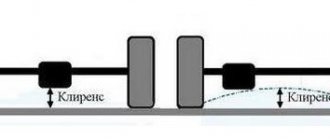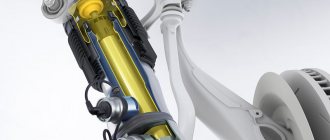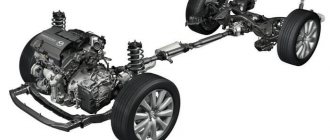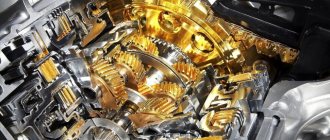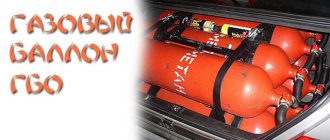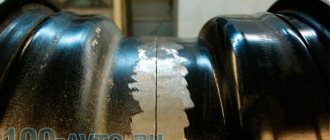What does the environmental class of a car show?
At the beginning of 2021, St. Petersburg took second place in the country in the anti-rating of cities with the dirtiest air - and this taking into account that the city has a small number of industrial facilities. The reason is the large number of cars that poison the air with exhaust gases.
What does the environmental class of a car show?
The European standard, which obligated manufacturers to modernize models and established a certain environmental class for the car, significantly reduced the amount of emissions into the atmosphere, but did not completely solve the problem. What is the environmental class of a car and what does it affect?
It is estimated that one average car per year with a mileage of 10,000 km consumes 4,100 kg of oxygen from the atmosphere and emits more than a ton of toxic substances, including lead, carbon monoxide and its compounds, sulfur dioxide, etc.
The environmental class of a car is a conditional gradation that reflects the amount and intensity of toxic waste that the car emits into the air. Today, automakers are required to comply with environmental standards and equip their vehicles with technologies and devices that reduce toxic emissions.
All vehicles today have a certain eco class or Euro standard, which depends on:
- year of production;
- fuel used;
- model, brand, country of origin;
- the presence of filter systems in the design.
Taking this into account, the car is allowed or prohibited to be used on the roads, brought into the country, crossed green areas, etc.
In 2021, the maximum environmental class for the Russian Federation is fifth.
Emission standards in Brazil
The motor vehicle emissions control program in Brazil is called PROCONVE. The first standard was introduced in 1988. In general, these standards correspond to European ones, however, the current PROCONVE L6, although it is an analogue of Euro-5, does not include the mandatory presence of filters for filtering particulate matter or the amount of emissions into the atmosphere.
Article on the topic
Instead of gasoline - sun. Students from St. Petersburg are creating the car of the future For cars whose weight does not exceed 1700 kg, the emission standards according to PROCONVE L6 are as follows (g/km):
- Carbon monoxide (CO) - 2
- Total hydrocarbon content (THC) - 0.3
- Volatile organic compounds (NMHC) - 0.05
- Nitrogen oxide (NOx) - 0.08
- Suspended Particulate Matter (PM) - 0.03
If the vehicle weight is more than 1700 kg, then the standards change (g/km):
- Carbon monoxide (CO) - 2
- Tetrahydrocannabinol (THC) - 0.5
- Volatile organic compounds (NMHC) - 0.06
- Nitric oxide (NOx) - 0.25
- Suspended particles (PM) - 0.03.
History of Euro certification
By the beginning of 1990, the purity of the atmosphere on the planet had catastrophically decreased. Cars running on gasoline and diesel engines were recognized as the most harmful to the environment. In 1992, a special regulation was developed in Europe, called the protocol for limiting the level of atmospheric emissions from road transport.
The first protocol was called Euro-1; the document specified the parameters of toxic emissions that were allowed to be emitted by cars.
Russia is a signatory to the Convention on Road Traffic adopted in Geneva. All restrictions prescribed in European environmental standards apply on the territory of the country.
The protocol is reviewed annually and the amount of permissible emissions is reduced. When developing the protocol, the following substances that constitute the concept of “vehicle emissions” are taken into account:
- Particles included in exhaust gases.
- Evaporation from a specific type of fuel.
US emissions standards
The US federal emissions standard for passenger vehicles is divided into three categories: low-emission vehicles (LEV), ultra-low-emission vehicles (ULEV) and super-low-emission vehicles (SULEV). There are separate requirements for each class.
In general, all car manufacturers and dealers in the United States adhere to EPA emissions requirements (LEV II):
| Category | Mileage (miles) | Non-methane organic gases (NMOG), g/mi | Nitrogen oxide (NOx), g/mi | Carbon monoxide (CO), g/mi | Formaldehyde (HCHO), g/mi | Suspended Particulate Matter (PM) |
| LEV | 50,000 | 0.075 | 0.05 | 3.4 | 0.015 | – |
| 120,000 | 0.090 | 0.07 | 4.2 | 0.018 | 0.01 | |
| ULEV | 50,000 | 0.040 | 0.05 | 1.7 | 0.008 | – |
| 120,000 | 0.055 | 0.07 | 2.1 | 0.011 | 0.01 | |
| SULEV | 120,000 | 0.010 | 0.02 | 1.0 | 0.004 | 0.01 |
How many environmental classes are there for a car?
- The first standard by which cars equipped with a gasoline engine were classified, Euro 1, began to operate in Europe in 1992. The protocol set minimum emission requirements. In the Russian Federation, the Euro-1 standard worked until 2005.
- The Euro-2 protocol was developed for EU countries in 1995; in the Russian Federation, the standard began to operate in 1999, along with the Euro-1 protocol. According to the protocol, the permissible level of emissions into the atmosphere was reduced by 100%, and fuel evaporation standards were tightened by 50%. Today, there are practically no cars with such a level of emissions - the engines are either recycled or modernized to a minimum percentage of emissions.
- The Euro 3 standard operated in the EU until 2004. The regulations included standards for both gasoline and diesel engines. For Russia, the protocol remained valid until 2013.
- Euro 4 was next. New amendments to the environmental class standard for cars were adopted in 2005. The Russian Federation joined the protocol in 2010. The standard tightened the amount of emissions and reduced the emission allowance standards by 40% compared to the previous protocol. Euro-4 was in effect in Russia until 2021. According to the standard, vehicles with an environmental safety class lower than Euro-4 could not be imported into the country. Manufacturers were required to upgrade engines in accordance with the protocol. Maximum emission standards for Euro 4:
- carbon dioxide - 4 g/km;
- carbon compounds - 0.55 g/km;
- solid carbons - 2 g/km.
- Euro-5 is the latest eco-standard that has been in force in the Russian Federation since 2015. European countries have been using the regulation since 2008. From 2021, the import of cars lower than Euro 5 into the country is prohibited.
Toxic emissions from cars into the atmosphere
Today there are restrictions on the entry onto public roads of cars whose environmental class is lower than that established for a certain zone. To increase the current eco class of a car, you need to:
- legally convert the engine;
- obtain an environmental inspection certificate;
- make appropriate amendments to the vehicle documentation at the State Traffic Safety Inspectorate.
Emission standards in China
In China, automobile emission control programs began to emerge in the 1980s, but a nationwide standard did not emerge until the late 1990s. China has gradually begun to implement stricter exhaust emission standards for passenger cars in line with European regulations. The equivalent of Euro-1 became China-1, Euro-2 - China-2, etc.
The current national automobile emission standard in China is China-5. It sets different standards for two types of vehicles:
- Type 1 vehicles: vehicles that can seat no more than 6 passengers, including the driver. Weight ≤ 2.5 tons.
- Type 2 vehicles: other light vehicles (including light commercial vehicles).
According to the China-5 standard, the emission limits for gasoline engines are as follows:
| Vehicle type | Weight, kg | Carbon monoxide (CO), g/km | Hydrocarbons (HC), g/km | Nitrogen oxide (NOx), g/km | Suspended Particulate Matter (PM) |
| 1 | All | 1 | 0,1 | 0,06 | 0,0045 |
| 2 | <1305 | 1 | 0,1 | 0,06 | 0,0045 |
| 1305-1760 | 1,81 | 0,13 | 0,075 | 0,0045 | |
| > 1760 | 2,27 | 0,16 | 0,082 | 0,0045 |
Vehicles with diesel engines have different emission limits:
| Vehicle type | Weight, kg | Carbon monoxide (CO), g/km | Hydrocarbons and nitrogen oxides (HC + NOx), g/km | Nitrogen oxide (NOx), g/km | Suspended Particulate Matter (PM) |
| 1 | All | 0,5 | 0,23 | 0,18 | 0,0045 |
| 2 | <1305 | 0,5 | 0,23 | 0,18 | 0,0045 |
| 1305-1760 | 0,63 | 0,295 | 0,235 | 0,0045 | |
| > 1760 | 0,74 | 0,35 | 0,28 | 0,0045 |
Why might you need an environmental class car?
You will need to find out what environmental class a car has if the model is bought abroad, imported into the country, or if you need to clear customs of a vehicle that has already been imported into the state.
Also, the constituent entities of the Russian Federation establish their own rules for collecting transport tax. The tax rate depends on the vehicle category, year of manufacture, and environmental class. There is no single tax rate in the Russian Federation; each region sets its own transport tax amounts.
In the transport tax return, line 110 in section 2 is reserved for indicating the environmental class. In addition, to accurately determine the environmental class of the car you will need:
- To understand which roads you can travel on legally.
- Is it necessary to convert the exhaust system to a higher one?
The exception is transport, which is considered self-propelled vehicles, i.e. The maximum speed of such a vehicle does not exceed 40 km/h.
euro-1
This standard introduced emission restrictions:
- nitric oxide;
- carbon monoxide;
- hydrocarbon.
Environmental regulations applied only to gasoline-powered vehicles. Diesel engines were still considered less hazardous to the environment, since soot emissions were not considered pollution.
Euro 1 requirements:
- nitrogen oxide content no more than 0.27 g/km;
- carbon monoxide content not more than 2.72 g;
- hydrocarbon content not more than 0.72 g.
These standards were met by installing catalysts in the exhaust system.
How to find out the environmental class of a car
There are several ways to check the environmental class of your car:
- study PTS;
- registration certificate;
- by VIN;
- through online services of government agencies.
According to STS
Only owners who have a new type of document in their hands have the opportunity to find out the environmental class of a car from the car’s registration certificate. In the new certificates, the environmental class is written in letters in the corresponding column; drivers comply with the requirement of signs 5.35. 5.36, 8.24 (passage of cars of the corresponding eco class).
Owners of the old certificate must exchange the STS, the effect of restrictive signs will apply to them from July 1, 2021.
According to vehicle title
In the PTS of the new model, the environmental class of the car is indicated in the 13th position. In old-style documents, the parameter may be on a different line; for some, the auto class is not set. In this case, the car is assigned a zero standard or Euro-1.
Through Rosstandart
The Rosstandart portal provides detailed data on manufacturers and summary tables of vehicle eco-class compliance by country and year of manufacture. Just go to the service and view the information you are interested in.
“Green” cars – saving the environment
In addition to the table by country and manufacturer, the service provides vehicle characteristics by make and model. The motorist needs to open the “Approval Information” page, enter the model and view the characteristics of the vehicle.
For example, for the Audi A8 the approval number is CU RU E-DE.AYA04.00070.P5I1, assigned Euro-5.
By VIN code
An effective option remains to check a specific car by VIN code through the environmental classes of Rosstandart cars. An electronic database for vehicle owners is provided on a separate page. 17 code characters are entered into a separate window; after a few minutes, the car owner receives detailed information on the model indicating the environmental class of the car.
If the manufacturer has not entered data on the emission standards that are present on a particular car, you must contact the State Traffic Safety Inspectorate with an application to assign a specific eco class after upgrading the car.
Fines in the Russian Federation for violating the standard
Today in the Administrative Code there is no article regulating the compliance of a vehicle with one or another eco class. Violators of environmental parameters are fined according to the list of parts of Art. 12.16 Code of Administrative Offenses, “Failure to comply with the requirements prescribed by traffic rules.” Namely:
- Violation of the “Left Turn” sign, Art. 12.16 p.2 fine – from 1000-1500 rubles.
- Movement of freight transport in the presence of a “No passage” sign, Art. 12.16 p.6., fine – 500 rubles. (except Moscow and St. Petersburg). If the violation occurs within these cities, the fine increases to 5,000 rubles.
- Art. 12.16 part 1 indicates that for any violation of the requirements of road signs, the driver will face either a warning or a fine of 500 rubles.
From 2021, the environmental class of a car will become a decisive factor in possible restrictions when driving on roads of a certain category. Car owners are recommended to replace the STS with a new document now and purchase cars on the secondary market that are at least Euro-4.
Gasoline: the difference between Euro 4 and Euro 5
Considering the differences between Euro-4 and Euro-5 for gasoline, if there is a choice, it is preferable to use Euro-5 fuel, since it contains less sulfur compared to Euro-4. The use of Euro-5 fuel does not worsen the condition of the car, even if it is old and runs on low-octane gasoline.
The higher the fuel class according to the Euro standard, the cleaner its composition. This is very important to ensure the quality and continuity of the motor. Fuel with a low sulfur concentration allows you to extend the life of lines, spark plugs, and injectors, thereby significantly reducing the amount of carbon deposits formed inside the combustion chambers.
Euro 5 gasoline is more favorable for lambda probes, as well as exhaust catalysts. The car's acceleration and dynamic characteristics are improved, and fuel costs are reduced.
The difference between the compositions of Euro-4 and Euro-5 gasoline fuels
Instructions for the most modern cars must contain an indication of the octane number of the fuel used, as well as its classification based on Euro standards. When specifying Euro-5 gasoline, it is undesirable to use fuel belonging to a lower class.
The basis of the chemical composition of these categories of fuel is the same. Such fuel is hydrocarbon, the raw material for it is oil. It is a common misconception that a higher octane rating of a fuel indicates greater purity.
However, the octane number only shows knock resistance, but not cleanliness. And Euro standards determine the level of purity of the fuel, the presence in its composition of substances harmful to nature, for example, gasoline with the number 92 is of the Euro-5 class, and gasoline 95 can also be classified as Euro-4.


